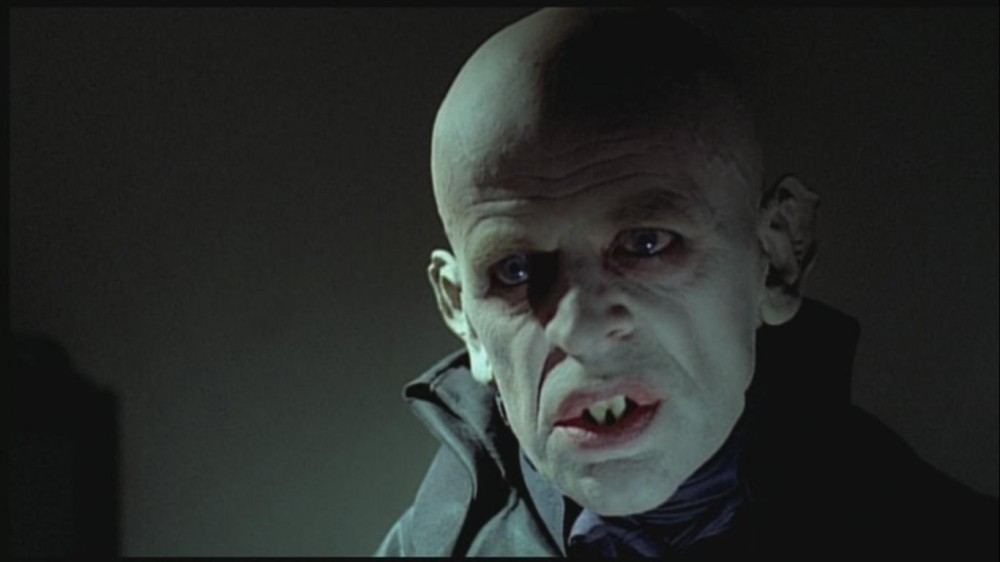
Nosferatu the Vampyre starts off with footage of choleric mummies in a Mexican crypt and only proceeds to get darker and more lugubrious as it goes along. On the surface, Werner Herzog’s adaptation of the similarly-named 1922 F.W. Murnau masterpiece could be seen as cinema’s umpteenth useless remake. This Count Dracula, even as incarnated by the inimitable Klaus Kinski, is a dead ringer for Max Schreck’s Count Orlof. They both have the same blindingly white complexion, the same rat-like features, and the same eerily affected manner. In fact, the movie lifts entire shots and compositions from the Murnau original, seemingly always running the risk of making itself obsolete. So how do you improve upon a genre-defining masterpiece of set design, cinematography, and atmosphere? In this case, the answer is simple: improve upon what was limited by the technology of the time. But the film’s use of sound and colour alone don’t explain why this film works: Herzog brings his characteristic massive scope to the table, expanding upon the template of the original film to create something idiosyncratic.
The story is essentially the same this time around: Jonathan Harker (a reliably solid Bruno Ganz) travels to the Carpathian Mountains of Eastern Europe to finalize a real estate deal with Count Dracula (Kinski), which would put the vampire in uncomfortably close proximity to his finacée Lucy (Isabelle Adjani). But that’s where the similarities end. The performances are meatier and more fleshed out this time around. Admittedly, this might have more to do with the advancement of film technology and the evolution of performance styles from the 1920s to the 1970s, but it’s still a feather in the film’s cap. Sure, Shreck’s Count was a creepy, otherworldly presence, living in the shadows and feasting on the living, but Kinski’s Count has all of that in addition to a voice. Plus, Kinski plays the Count not only as predatory, but as lonely. In that same vein, as good as Greta Schröder was, she didn’t have the piercingly intense eyes and hollow, defeated voice of Isabelle Adjani, nor did she have the same will or agency to alter the story’s course. All of this is supplemented by Herzog’s camerawork, combining the German expressionism of the source material with a dour, muted colour palette and his own formidable skill at filming and framing nature. Both thematically and formally, Nosferatu the Vampyre is not only a masterclass in film-making, but a masterclass in how to reinterpret an oft-told story.
Nosferatu the Vampyre, like many of the adaptations of Bram Stoker’s novel, examines in its own ghoulish way the intricate link between sex, power, and fear. But unlike most interpretations, and more explicitly that Murnau’s original film, Herzog’s film is more concerned with disease and infection; if the metaphor wasn’t already clear enough, Herzog unleashes a horde of white rats into a very real street about halfway though the film. As a symbol of nature taking over, it isn’t exactly subtle, but it is quite effective, in part because those are actual rats in an actual town. Towards the film’s conclusion, ready to concede the victory to the forces of nature, the townsfolk end up burning plagued bodies and otherwise having a merry old time in a world where the social order has been nuked. Societal breakdowns are nothing new in Herzog’s work at this point, and for that matter neither is trying to curb the awesome power of the wild. But as deployed here, the white rats and the displays of nihilism and decadence add a welcome bit of apocalyptic texture to a straightforward vampire story. As is true in most of Herzog’s films, nature is chaotic and attempts to control it will result in failure, injury, or death.
Ultimately, like the film it borrows from, Nosferatu the Vampyre is a masterful exercise in mood, atmosphere, and tension. As if to underscore how brooding this film is, the proceedings are underpinned by an ooky-spooky Moog-heavy score by Herzog vets Popul Vuh. That said, everything in the film, from the photography and score to the performances and the Wernerisms in the script, is calibrated for maximum foreboding. But its biggest success is probably extratextual: it proves that remakes (or reboots, or companion pieces, or whatever this film may be) can be just as rewarding as original works through the perfect balance between the original’s skeleton and the interlocutor’s voice.
–
Nosfetartu the Vampyre is available on DVD and Blu-Ray from Amazon.
Directed by Werner Herzog; written by Werner Herzog; adapted from the novel Dracula by Bram Stoker; starring Klaus Kinski, Isabelle Adjani, Bruno Ganz, Roland Topor, and Walter Landengast; 107 minutes.



 Derek
Derek
 Isabelle
Isabelle